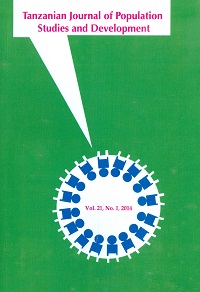Hazardous Settlements and their Implications in Urban Tanzania: A Case Study of Iringa Town
Abstract
Rapid urbanization and inadequate capability to cope with the housing needs of urban populations have contributed to the development of hazardous settlements in urban areas. This study examines the patterns of growth of hazardous settlements in Iringa, Tanzania, the associated risks and their implications. Due to the complexity of the problem, the study employed mixed research approaches in data collection and analysis, including documentary review, interviews and questionnaires, focus group discussions, field observations and photography. The findings revealed that residents of age group of between 18 and 44 years were the majority in hazardous settlements, and the majority of household heads were married females. Factors contributing to people to reside in hazardous settlements include failure to get surveyed plots, proximity to work places, business opportunities, clashes with landlords, and chances to get free plots. Hygienic risks were cited to be the main problems facing residents in hazardous settlements. Other problems were inadequate social services, environmental risks, crimes, fear from forceful evictions and urban poverty. To resolve the problems associated with hazardous settlements, the study recommends, among others, that the government reviews urban planning policies, plans and standards; and that urban authorities should collaborate with utility service institutions to plan and institutionalize policies for urban settlements.
References
Arusha Municipal Council (AMC). A Brief Paper on Solid Waste Management: Case Study of Arusha Municipality. Paper prepared for the International Workshop on ' Solid Waste Collection That Benefits the Urban Poor ' , 9th -14th March, 2003, Arusha.
Asian Development Bank (ADB). 2001. Final Report: Alternative Livelihoods Project, July. Suva, Fiji: ADB.
Awinia-Mushi, C. 2013. Examining Urban Poverty, Inequality and Human Capability Development in the Context of Adjustment: The Case of Vingunguti and Buguruni Settlements, Dar es Salaam. Ph. D. Thesis, Open University of Tanzania.
Fell, R., K. Ho & S. Lacasse. 2005. A Framework for Land Slide Risk Assessment and Management. A research report.
Huchzermeyer, M. & A. Karam. 2006. Informal Settlements: A Perpetual Challenge? Juta Academic Press.
Kironde, J. 1977. The Access to Land by the Urban Poor in Tanzania, Some Findings from Dar es Salaam. Environ Urbanization, 7(1): 77-95.
Kombe, W. 1977. The Inner City Informal Land Management Dynamics: Threats to Private and Public Welfare. Paper presented at the international conference on ' Between State Control and the Market €“Informal Responses to Formal Land Management under Rapid Urban Growth ' , Dortmund, 1997.
McGranahan, G., J. Songsor, C. Surjadi, M. Kjellen & P. Jacobi. 2001. The Citizens at Risk. From Urban Sanitation to Sustainable Cities. London: Earthscan.
Mkuyu, S. S. 2013. Managing Urban Areas in Tanzania through Master Plan. A Case of Dodoma Town. MA dissertation, University of Dar es Salaam.
Napier, M. 2000. Human Settlements and the Environment. Report prepared for the Department of Environmental Affairs & Tourism, Pretoria, South Africa. Available on: http://www.environment.gov.za/soer/index.htm.
United Nations Centre for Human Settlements (UNCHS). 2001. Guidelines for Operational Programme Formulation in Post Disaster Situations: A Resource Guide. Nairobi, Kenya.
United Nations Environment Programme (UNEP). 1998. Water-Related Environmental Issues and Problems of Comoros and Their Potential Regional and Trans boundary Importance. TDA/SAP-WIO. Maputo.
UN-Habitat. 1996. A Global Report on Human Settlements. An Urbanizing World. Nairobi: Oxford University Press.
UN-Habitat. 2003. The Challenge of Slums. Global Report on Human Settlements. Nairobi: Earthscan Publication.
United Republic of Tanzania (URT). 2013. Budget Speech. Ministry of Lands, Housing and Human Settlements Development
€”. 2002. Population and Housing Census General Report. Dar es Salaam: Government Printer.
€”. 2000. National Human Settlements Development Policy of 2000. Ministry of Lands and Human Settlements Development. Dar es Salaaam. Government Printer
World Health Organization (WHO). 1999. Environmental Health Indicators: Framework and Methodologies. Geneva: WHO. (Available at http://www.who.int/docstore/peh/ archives/EHIndicators.pdf).
WHO & UNICEF. 2000. Global Water Supply and Sanitation Assessment 2000 Report. New York.


